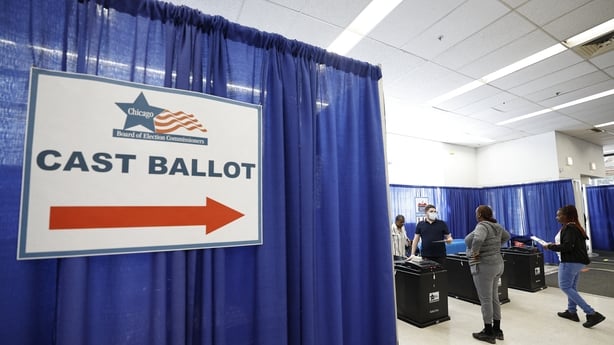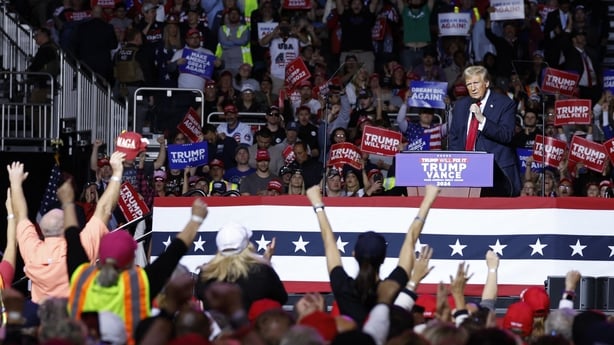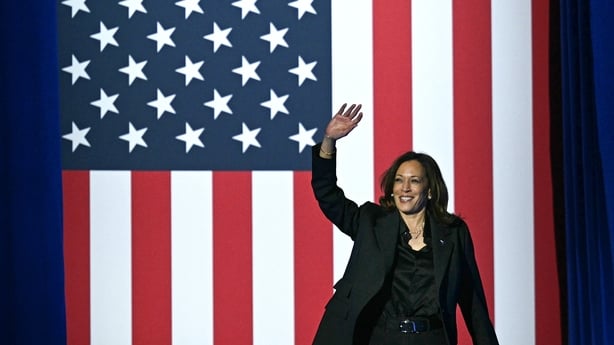The US presidential election is now into the endgame.
It is all over for the campaigns: the votes are being cast, and the results will follow - though if it is as close as the polls suggest, the definitive results may be some time away.
On results night, all eyes will be on seven states: Arizona, Georgia, Michigan, Nevada, Pennsylvania, Wisconsin and North Carolina.
These are the battlegrounds that are not predictable for one candidate or another. That is why the candidate - and the media - pay so much attention to just a handful of states.
RTÉ's coverage will be pulled together from states such as Pennsylvania, Michigan and Wisconsin - the so-called Blue Wall states - and from Georgia, Nevada and Arizona - the sunbelt states.
And also from North Carolina (16 votes), which has emerged as a swing state since the Harris candidacy, but which was also hit by a devastating hurricane that may have an impact on the outcome there.
To understand why, you have to appreciate that the US Presidential election consists of 50 separate elections - one for each state of the union.
To respect the formal sovereignty of each state, and reflect the different population sizes of the states, the US constitution decrees that the president is elected by an "Electoral College", made up of delegates, or electors, from each state.
If you win the presidential election in that state, you win that state's allocation of votes in the electoral college.
The electoral college vote of each state is determined by population. Every State is allocated a number of votes equal to the number of senators and representatives in its US Congressional delegation - two votes for its Senators in the US Senate plus a number of votes equal to the number of its congressional districts.
So crowded California gets 54 votes, but empty Alaska gets three.

In total there are 538 votes in the electoral college, so to win the presidency, a candidate needs a simple majority of 270 votes.
Getting there requires winning a combination of states that deliver at least 270 votes to a candidate.
So while Joe Biden had a seven million vote advantage over his republican rival in the popular vote, in the electoral college, some election experts think if 48,000 votes spread over three states had gone the other way, Donald Trump would be finishing his second term in the White House about now.
That is why the seven swing states are vital in this process: they determine the outcome.
And because the opinion polls suggest there is not a cigarette paper between the candidates in most of the seven swing states, results night could be a real nail-biter and will leave open the way to a massive row over who actually won the election.
The polarised nature of US politics has meant most states are "callable", they can be assigned to a party before the candidates are even chosen.
New York, California and Illinois provide the big blocks of votes for the Democrats, Texas, Florida and Ohio for the republicans.
In this century the election has come down to a handful of battleground or swing states which are those that cannot be called for one party or the other.

These are the states the campaigns focus their time, money and efforts on.
Unless there is a political earthquake somewhere, 43 states are pretty much locked off for this election. (Some democrats fantasise about flipping Texas - that would be an earthquake of magnitude ten on the Richter scale!).
So it all comes down to the seven swing states, that is where the action is, and where the campaigns have been.
Over the last three weeks or so, we too have hit the swing states, trying to capture something of the battles in each - because they are all different.
There are 93 electoral college votes up for grabs in the seven swing states.
Trump needs to win 51 of them to break the 270 Electoral College vote target: Harris needs 44 to win.
There are various combinations of states and votes that could tip the election one way or the other: 20 winning combinations for the democratic Candidate, 21 winning combinations for the republican candidate.
However the key state is Pennsylvania, with its block of 19 votes.
If Trump can win Pennsylvania and one other Blue Wall state, he will likely win the presidency.

Harris pretty much has to win Pennsylvania if she is to become the first woman to sit behind the resolute desk in the Oval Office.
Her path to victory is easiest - relatively speaking - if she sweeps the Blue wall states, so called because they have been traditional democratic strongholds, which gets her to a bare 270 votes in the electoral college.
However she could still win without taking Pennsylvania, if she wins in the traditionally republican strongholds of Georgia, North Carolina and Arizona, along with Wisconsin.
And just to really tie you in knots on results night, there are three combinations of the seven swing states that result in a tie, each candidate getting 269 electoral college votes, according to the website 270towin.com.
The below gives some background to Tuesday night/Wednesday morning’s election results coverage, a way of understanding why some states are more important than others in this election, and some appreciation of the issues that are shaping voters' decisions in those states.
The numbers are the what, the background is the why.
Read more
Pennsylvania - Erie vibes: We visit a US swing town that often picks the winner
Michigan - Kamala Harris has a problem and it's called Gaza
Wisconsin - America's Dairyland was decided in Joe Biden's favour by just 22,000 votes
Georgia - Authorities here expect a record number of voters will turnout by the time polls close
Nevada - Both Trump and Harris have supported exempting taxes on tips for service workers
Arizona - Joe Biden won in the southern state in the last election by just under 10,500 votes
North Carolina - A state hit hard by Hurricane Helene at the end of September
What struck me on this tour was a truth often told, the diversity of the states. In geography, climate, time zones, people and cultures, these are different with very different concerns and viewpoints.
When I was Europe Editor I used to tell my bosses that Europe happens beyond the Brussels ring road, a sort of nudge to send me away from the political capital of the EU to where policy met real life. The same is true over here.
The United States of America happens beyond the DC beltway. Washington is just a venue. All politics are local.






